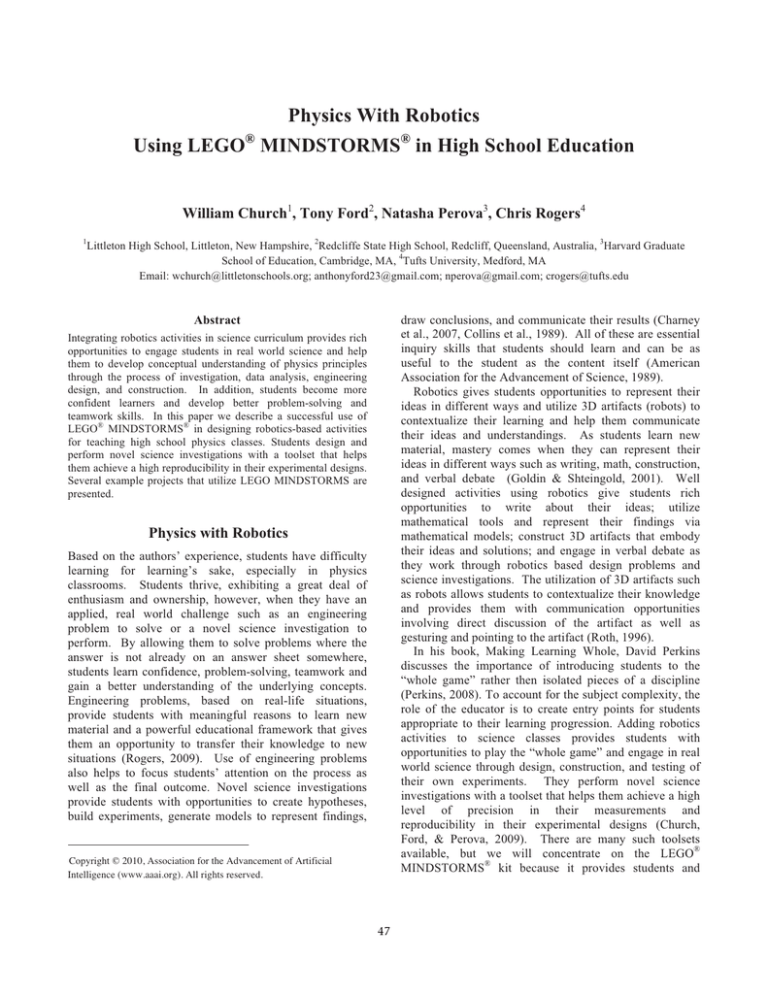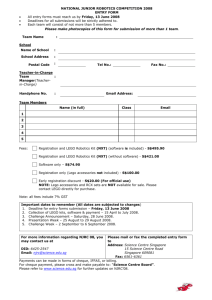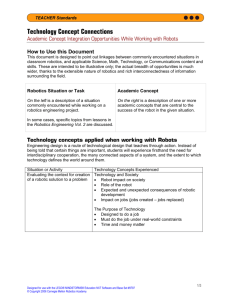
Physics With Robotics
Using LEGO® MINDSTORMS® in High School Education
William Church1, Tony Ford2, Natasha Perova3, Chris Rogers4
1
Littleton High School, Littleton, New Hampshire, 2Redcliffe State High School, Redcliff, Queensland, Australia, 3Harvard Graduate
School of Education, Cambridge, MA, 4Tufts University, Medford, MA
Email: wchurch@littletonschools.org; anthonyford23@gmail.com; nperova@gmail.com; crogers@tufts.edu
draw conclusions, and communicate their results (Charney
et al., 2007, Collins et al., 1989). All of these are essential
inquiry skills that students should learn and can be as
useful to the student as the content itself (American
Association for the Advancement of Science, 1989).
Robotics gives students opportunities to represent their
ideas in different ways and utilize 3D artifacts (robots) to
contextualize their learning and help them communicate
their ideas and understandings. As students learn new
material, mastery comes when they can represent their
ideas in different ways such as writing, math, construction,
and verbal debate (Goldin & Shteingold, 2001). Well
designed activities using robotics give students rich
opportunities to write about their ideas; utilize
mathematical tools and represent their findings via
mathematical models; construct 3D artifacts that embody
their ideas and solutions; and engage in verbal debate as
they work through robotics based design problems and
science investigations. The utilization of 3D artifacts such
as robots allows students to contextualize their knowledge
and provides them with communication opportunities
involving direct discussion of the artifact as well as
gesturing and pointing to the artifact (Roth, 1996).
In his book, Making Learning Whole, David Perkins
discusses the importance of introducing students to the
“whole game” rather then isolated pieces of a discipline
(Perkins, 2008). To account for the subject complexity, the
role of the educator is to create entry points for students
appropriate to their learning progression. Adding robotics
activities to science classes provides students with
opportunities to play the “whole game” and engage in real
world science through design, construction, and testing of
their own experiments. They perform novel science
investigations with a toolset that helps them achieve a high
level of precision in their measurements and
reproducibility in their experimental designs (Church,
Ford, & Perova, 2009). There are many such toolsets
available, but we will concentrate on the LEGO®
MINDSTORMS® kit because it provides students and
Abstract
Integrating robotics activities in science curriculum provides rich
opportunities to engage students in real world science and help
them to develop conceptual understanding of physics principles
through the process of investigation, data analysis, engineering
design, and construction. In addition, students become more
confident learners and develop better problem-solving and
teamwork skills. In this paper we describe a successful use of
LEGO® MINDSTORMS® in designing robotics-based activities
for teaching high school physics classes. Students design and
perform novel science investigations with a toolset that helps
them achieve a high reproducibility in their experimental designs.
Several example projects that utilize LEGO MINDSTORMS are
presented.
Physics with Robotics
Based on the authors’ experience, students have difficulty
learning for learning’s sake, especially in physics
classrooms. Students thrive, exhibiting a great deal of
enthusiasm and ownership, however, when they have an
applied, real world challenge such as an engineering
problem to solve or a novel science investigation to
perform. By allowing them to solve problems where the
answer is not already on an answer sheet somewhere,
students learn confidence, problem-solving, teamwork and
gain a better understanding of the underlying concepts.
Engineering problems, based on real-life situations,
provide students with meaningful reasons to learn new
material and a powerful educational framework that gives
them an opportunity to transfer their knowledge to new
situations (Rogers, 2009). Use of engineering problems
also helps to focus students’ attention on the process as
well as the final outcome. Novel science investigations
provide students with opportunities to create hypotheses,
build experiments, generate models to represent findings,
Copyright © 2010, Association for the Advancement of Artificial
Intelligence (www.aaai.org). All rights reserved.
47
teachers with a high number of project possibilities without
significant equipment constraints. Additionally, many
students are familiar with LEGO, their modular design
allows for multiple solutions to a given assignment, and the
sensors and motors that are compatible with LEGO
MINDSTORMS allows high school physics students to
engage in a very diverse set of engineering and science
activities. For example, students can explore the limits of a
sound sensor when designing better ear protection,
investigate the phenomena of reflection and light intensity
with light sensors, experiment with magnetic field forces to
create a navigation system, and engineer gear ratios when
designing a drag car.
What is fundamental to these
robotics based activities and what makes them rich
learning experiences is the synthesis between science
investigation and engineering design, a synthesis that
closes the gap between “the concepts and skills of physics
and the practical use of those skills [helping] students take
what the learn in the classroom and use it in the rest of
their lives” (Church, Ford, & Perova, 2009, p. 9).
Ten Second Timer. In this project, students will use their
understanding of simple harmonic motion to engineer a
mechanical 10-second timer that utilizes an external
pendulum based clock. Students work in teams to design a
pendulum and sensor package to count swings. Their
system is successful if it marks 10 seconds with an audio
and/or visual display (Figure 1). The learning objectives
for this project are:
• Use an idealized system (simple pendulum) to make
predictions about the period of a physical pendulum.
• Apply predicted performance of a physical pendulum in
the engineering design process of a mechanical timer.
• Use MINDSTORMS sensors to measure the
performance of the system and compare with a calibrated
timer such as a watch.
Example Activities
What follows are example projects that utilize LEGO
MINDSTORMS in high school curricula. For each
example, we will present a project overview and learning
objectives. At least two of these projects will be available
for evaluation at the conference. More examples are
provided in our book, Physics With Robotics – An NXT
and RCX Activity Guide for Secondary and College
Physics (Church, Ford, & Perova, 2009).
Testing Speed vs. Acceleration of Drag Cars. Students
work in a team to figure out which is more important in a
drag race – Speed or Acceleration. After a design/build
iteration, students use a rotation sensor to measure
distance, speed, and acceleration of their car. They upload,
view, and analyze motion graphs via the data logging
function of a LabVIEW™ program.
The learning
objectives for this project are:
• Describe motion in terms of speed and acceleration.
• Compare various factors that may affect speed and
acceleration of an object including power, time of travel,
gear ratio and wheel size.
• Utilize a scientific experiment to inform the engineering
design process with the goal of maximizing acceleration
and speed.
Simple Harmonic Motion. In this experiment, students
use a LEGO microcontroller and an ultrasonic sensor to
investigate the change in vertical motion of an oscillating
spring. Calculations of the amplitude and period can be
made using the data from the resulting graph. The learning
objective for this project is:
• Study periodic motion and the characteristics of a
displacement graph that represents simple harmonic
motion.
Figure 1. Student built “Ten Second Timer” based on a LEGO
beam based physical pendulum. In this design, the students’
timer counts swings with a light sensor and indicates when 10
seconds has elapsed via a visual display on the screen and an
audible tone.
Microphone Sound Reduction. In this activity, students
explore sound waves. Specifically, they use a LEGO sound
sensor to explore a sound wave’s intensity by designing
experiments to investigate the variables that affect the
measurement of a sound wave’s loudness. For example,
students explore variables such as the distance between
sound source and microphone, sound wave direction and
shape (approximated by a cone or sphere), the frequency
response of the MINDSTORMS microphone, and the
conductivity of sound through different media. Finally,
they design better “ear” protection for the sound sensor by
taking what they have learned through the science
investigation and applying it to an engineering design
problem. The learning objectives for this project are:
• Describe sound waves in terms of a transfer of energy
48
• Measure the loudness of a sound wave and relate this
measurement to a wave’s amplitude, energy, power, and
intensity.
• Create an experiment that investigates which variables
affect the measured loudness of a sound wave.
• Engineer ear protection that reduces the sound levels
measured by the microphone.
for conceptual knowledge development through the
process of design, construction and experimental testing. In
this paper, we described several classroom-tested activities
that target the topics of speed, acceleration, simple
harmonic motion, and sound waves. We found that these
experiments provide a powerful educational framework by
combining science investigations and engineering design,
where students not only learn the concepts and the skills of
physics but the practical application of their knowledge as
well. Students have opportunities to develop their
teamwork and communication skills and become more
independent and confident learners.
Discussion
When we developed the activities outlined in this paper,
we based their design on own classroom observations,
shared observations with other instructors, and relevant
literature. Claims related to student learning through our
activities are based on observations of hundreds of students
in our respective institutions that span secondary and post
secondary levels in United States and Australia. Example
observations are outlined below.
When compared with other velocity vs. acceleration
activities we have conducted, we observe more students
engaged in our drag car activity that exhibit a high level of
ownership and investment in their work. With this
ownership and investment, and scaffolds built into our
activity, students work through their confusion regarding
the concepts of velocity and acceleration via design
iterations, artifact mediated conversations with teammates
and teacher, feedback from real-time motion graphs, and
performance feedback. This last point – performance
feedback -- makes a big difference in the classroom.
Students want to achieve the goals of the assignment. In
this assignment, they want their LEGO cars to have a high
velocity or have a high acceleration. Toward achieving
this goal, they invest a great deal of energy in problem
solving. When demonstrating and explaining their drag car
creations, they confidently showcase their improved
understanding of velocity and acceleration.
This exploration and refinement is also encouraged in
the ten-second timer and sound reduction activities. As
with many secondary level physics activities, complex
mathematical relationships are involved. By using the
hands-on robots and the data coming in from sensors to test
and check the results of their design ideas, a greater
diversity (compared with our past observations from
teaching the same content via different teaching strategies)
of students move past their confusion with the complex
mathematical relationships to confidently create solutions
to design challenges. We observe them using correct
physics reasoning to explain the performance of their
designs.
We recognize that our evidence is anecdotal and that
more formal studies are needed.
References
American Association for the Advancement of Science.
1989. Science for all Americans: A project 2061 report on
literacy goals in science, mathematics and technology.
Washington, DC.: AAAS Publication 89-01S.
Charney, J., Hmelo-Silver, C.E., Sofer, W., Neigeborn, L.,
Coletta, S., & Nemeroff, M. 2007. Cognitive
apprenticeship in science through immersion in laboratory
practices. International Journal of Science Education, 29,
195-213.
Church, W., Ford, T., & Perova, N. 2009. Physics With
Robotics – An NXT and RCX Activity Guide for Secondary
and College Physics. Knoxville, TN.: College House
Publishing.
Collins, A., Brown, J. S., & Newman, S. E. 1989.
Cognitive apprenticeship: Teaching the crafts of reading,
writing, and mathematics. In L. B. Resnick (Ed.),
Knowing, learning, and instruction: Essays in honor of
Robert Glaser (pp. 453–494). Hillsdale, NJ.: Erlbaum.
Goldin, G., & Shteingold, N. 2001. Systems of
representations and the development of mathematical
concepts. In A. A. Cuoco & F. R. Curcio (Eds.), The
roles of representation in school mathematics. NCTM
2001 yearbook (pp. 1–23). Reston, VA.: National
Council of Teachers of Mathematics.
Perkins, D. 2008. Making learning whole: How seven principles of teaching can transform education. San Francisco,
CA.: Jossey-Bass.
Rogers, C. 2009. Introduction. Physics With Robotics –
An NXT and RCX Activity Guide for Secondary and
College Physics by William Church, Tony Ford, and
Natasha Perova. Knoxville, TN.: College House
Publishing.
Conclusion
Roth, W.M.. 1996. Art and artifact of children's designing: A
situated cognition perspective. Journal of the Learning
Sciences. 5(2): p. 129-166.
Using LEGO MINDSTORMS robotics activities to teach
physics concepts creates an effective learning environment
49


